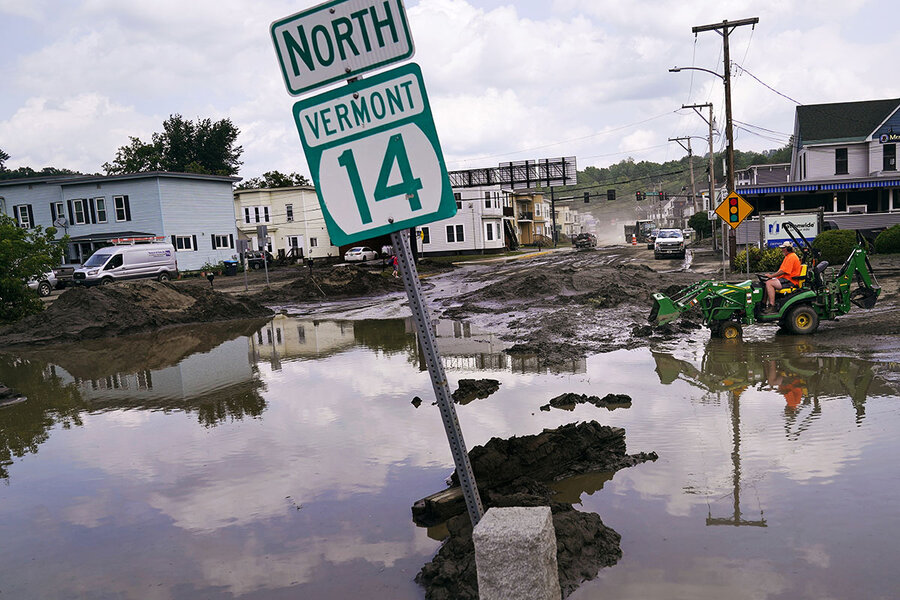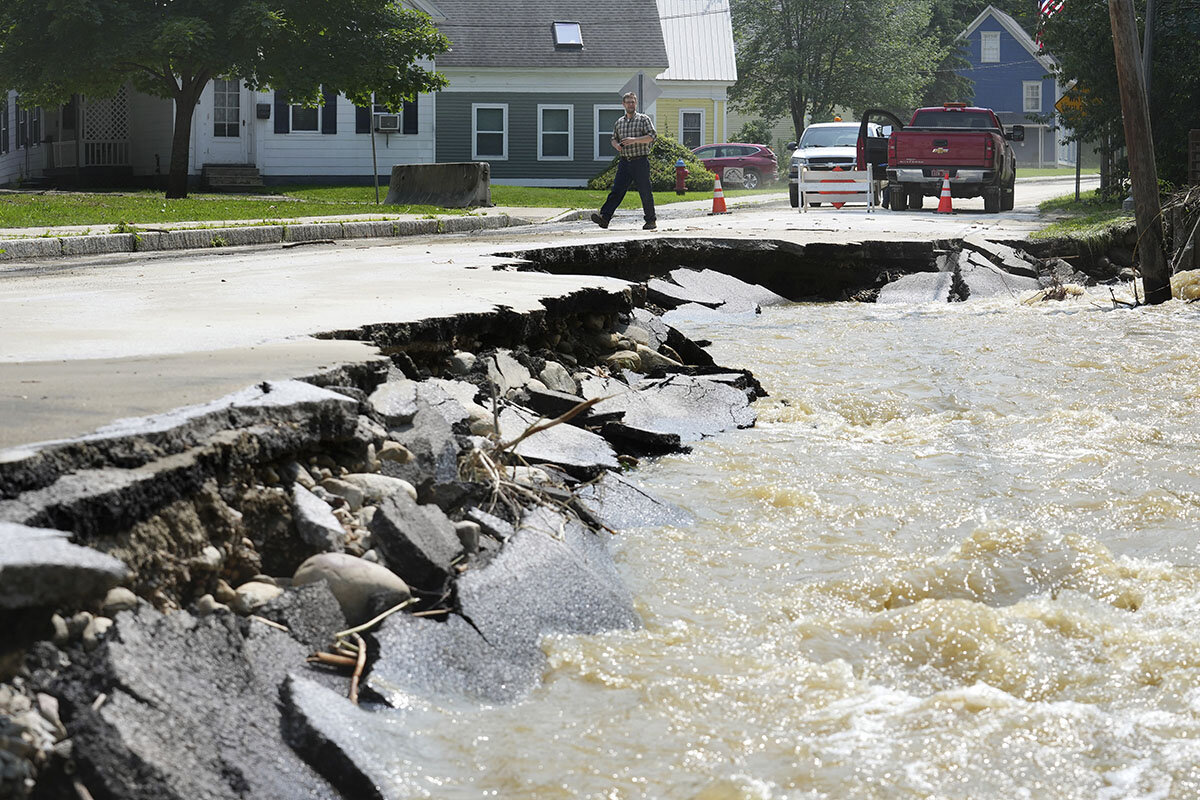They moved to Vermont for climate safety. Then came floods.
Loading...
| Boston; and Brandon, Vt.
Growing up on the west coast of Florida, Joanna Banks-Morgan had become blasé to hurricanes and tropical storms. They were a part of life. But in October 2018, when Hurricane Michael jumped from Category 2 to 4 in just hours in the middle of the night, and her daughter’s home was destroyed, her perspective began to shift.
Less than a month later – and all the way across the United States – Ms. Banks-Morgan’s father lost his home in California to a wildfire. Her daughter, who had temporarily moved in with him, was evacuating once again. This time, alligators lurking in washed-out streets were replaced by fires blazing on either side of the road that they traveled from Malibu to Los Angeles.
“It was such a wake-up call,” Ms. Banks-Morgan explains. To dodge such risks, she and her husband moved to Sudbury, Vermont, in February 2019. Nestled between mountains and farmland, the town of 500 is idyllic and far from warming ocean waters.
Why We Wrote This
A story focused onExtreme weather events have been persistent and global. The result can be a perspective shift, even in areas of relative shelter from the effects of climate change.
But Vermont had its own wake-up call in July as massive rains caused bridge washouts, flooding, and damage to roads and properties in the state.
“We were supposed to be in a safe place, and this huge storm comes through and our safe place is suddenly not safe anymore,” says Ms. Banks-Morgan.
She describes the floods and related tornado warning as traumatic. And, although her home didn’t experience water damage, her normally 12-minute commute slowed to 45 minutes in the aftermath.
The weather of 2023 seems to have dealt a harsh blow to the notion that some areas can be havens from climate change. Extreme conditions have been popping up everywhere all at once, from wildfires in Hawaii, to floods in Libya and elsewhere, to persistent global heat waves this summer. Here in New England, soils are saturated this week by another big rain, even as Hurricane Lee threatens to swipe parts of the region this weekend. Climate scientists have cited human-caused warming of Earth’s air and oceans as a likely intensifier of these events.
Some areas really are more insulated than others from the harshest risks of climate change, they say. It’s just that no place is truly isolated from the global trend. People who have migrated partly for climate reasons are having to cope with this, even if they don’t regret their moves.
“I still feel safer here than in other parts of the country because I believe Vermont and its government will do something to make changes, whether it’s to infrastructure in some of these towns or putting regulations in place that will help the environment,” says Ms. Banks-Morgan.
Sheltered from climate effects?
In the past few years, Vermont has earned high rankings for its relatively low climate risk. A 2020 ProPublica report classified four Vermont counties as part of the top 10 across the country that are least likely to suffer from climate change effects like wildfires, extreme heat, and sea level rise. In April 2022, a real estate professor at Tulane University told CNBC that Burlington, Vermont, is a “safe haven” for Americans fleeing extreme weather.
But “there’s no such thing as a climate safe haven anywhere on the planet. Every place is going to experience some form of an effect, whether it is extreme acute events or the long-term chronic events. There’s going to be change,” says Carlos Martín, who researches the intersection of housing and climate change at Harvard’s Joint Center for Housing Studies.
Some communities like Buffalo, New York, and Duluth, Minnesota, have advertised themselves as havens to buoy declining populations. In Vermont, too, several counties have been losing population, he says.
“They have a declining population, and they see themselves as relatively lower [in climate effects] than Louisiana, Texas, Florida, and California. So I think that it makes sense from a political standpoint to say, ‘We want more population,’” says Dr. Martín.
Earlier this year, some Vermont state lawmakers told NBC5 that they’re expecting and preparing to harbor growing numbers of people displaced by droughts, wildfires, hurricanes, and floods.
The state saw a major jump in population in 2021, but experts say it correlated with the pandemic and not climate migration. Even so, real estate agents across the state have testified to helping climate migrants find homes. Sources told the Monitor that anywhere from 10% to 25% of their clients move in part to get away from fires and because of Vermont’s “more predictable weather patterns.”
Elizabeth Fussell, a demographer and sociologist at Brown University, believes these movers are part of an emerging trend – one that reflects a changing rationale among Americans.
“When people in the U.S. see a destructive event like a wildfire, hurricane, tornado, or a flood, they typically use the tools that we have at hand – FEMA money and insurance – to rebuild and restore themselves to their pre-disaster condition,” she says. But “that logic is being reconsidered at the federal and individual levels where people are questioning whether it makes sense to continue rebuilding when they’re living in a repeat hazard area.”
This trend is not widely studied yet. “Climate migration” in academic research typically refers to migrants from places that become uninhabitable.
In the emergence of preemptive migration, climate is usually one of several factors behind a household’s decision, experts say. It’s also about housing, community, job opportunities, schools, and other costs.
Dr. Martín notes the high insurance rates in California and Florida, which are indirectly related to climate change and could actually be the driving force behind migration.
The climate resiliency factor
For those with the resources and a degree of climate anxiety, Vermont is an appealing destination.
Erika Faulkner, an organizer at the environmental activist group Vermont Conservation Voters, moved to Vermont in 2020. Climate change has guided her decision-making since second grade, she remembers. “I have this vivid memory of learning about global warming and asking my dad if all the adults were aware that it was happening and when our home in Lancaster, Pennsylvania, would turn into a beach,” she says. “So I have always had this climate anxiety that bad things are going to happen as climate change gets worse.”
After graduating from Dickinson College, Ms. Faulkner was weighing job opportunities. “I researched all of the states and towns I was considering, and the biggest thing for me was how they were doing on climate issues, and on resiliency,” she says.
She paid attention to other factors, too, but climate change was “definitely the main one.” Vermont was far less polluted than other states and, at the time, did not suffer from wildfire smoke. And, importantly, she could find a job. Ms. Faulkner majored in environmental science, with a specialization in resilience. “Vermont is well known for their climate policy, and so I could actually find a climate resilience-focused job,” in contrast to her home state of Pennsylvania, she explains.
According to environmental economist Austin Anaya, Vermont ranks 11th on climate policy in a comparison of all 50 states.
The politics in Florida also contributed to Ms. Banks-Morgan’s move away from the South. She has more confidence in legislators in Vermont than in Florida to act, and “these disasters terrify me,” she says. “They make me think that we have to get across to our politicians that we have to do something about climate change. ... You know, this is not a dress rehearsal. This is it.”







